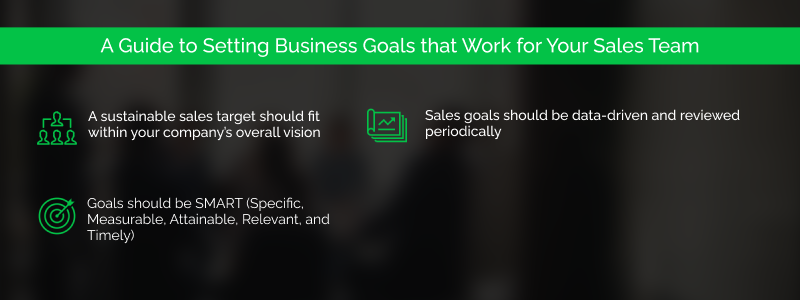The 7 Most Important KPIs for Recruiters
As a recruiter, you should always take advantage of recruitment KPIs to measure the effectiveness


Setting business goals for your team is a critical step in any company’s success. With the right objectives, you can easily track your progress, recognize areas for growth, and ensure that your team is all on the same page. The problem is that it isn’t always easy to figure out which targets are realistically achievable and which aren’t. So how do you set goals that actually work in the first place?
Here are some simple steps you can take to establish practical sales goals for your team.
Setting sales goals is an effective way for a business to achieve sustainable economic growth. These objectives can involve specific strategies such as:
Properly setting sales goals is vital to understanding the effort required to achieve them and how long it will take to reach your desired outcomes. This gives you a realistic idea of where your business is headed and can also help you identify weak spots that need improvement.
Now that you understand the purpose and value of setting sales goals, let's look at how to create them.
Start by setting long-term goals that will help keep you on track and focused. Then break the long-term goals into short-term, more manageable steps that you can use to achieve your objectives. Make sure these goals are realistic but also challenging enough to move your company forward. If they're too easy, there won't be much motivation to achieve them.
The Harvard Business Review recently published an interesting article suggesting that if most salespeople are struggling to meet their goals, it might not be the salespeople who are at fault but the goals themselves. In their words: "When 10%–20% of salespeople miss goals, the problem might be the salespeople, and vice versa is true."
Setting SMART (Specific, Measurable, Achievable, Relevant, and Timely) goals involves breaking each objective into smaller, more manageable milestones that are specific, measurable, and relevant to your overall plan. For example, you might set a goal to increase your monthly revenue by 5% over three months or reach out to 100 new customers each week. By setting these small but achievable targets, you can easily track your progress and stay motivated as you work towards achieving them over time.
SMART sales goals help companies focus their efforts and resources on attainable objectives that can be monitored through analytics and metrics. And here is how it works.
When setting sales goals, start by assessing your current situation. Take a look at factors such as the size of your team, the available resources, and the strength of your customer base. Understanding these variables can help you set realistic targets.
One helpful tool for assessing your current situation is historical data analysis. This can provide valuable insights into patterns and trends that can be used to inform both short and long-term planning. Armed with this information, you’ll be better positioned to set achievable goals for your sales team.
By determining what your team needs to attain success, you can work with them to meet their goals. Sustainable economic growth occurs when companies invest in their employees and provide them with the tools and training they need to succeed.
By setting sales goals and equipping your team with the resources they need to achieve them, you can have confidence that they will thrive. Clear objectives and the right tools help employees understand what they need to do to drive sustainable business growth.
Keeping track of progress is essential to achieving sales goals. It allows you to adjust and pivot as needed to ensure continued success. Regularly monitoring performance lets you identify what’s working and what’s not, making it easier to adapt your approach and tactics accordingly.
Additionally, monitoring progress helps you assess whether you’re on track to achieve your long-term goals. It provides valuable insights into which activities contribute to success and where improvements can be made.
And that’s it. Just by following those simple steps, you can start setting realistic, achievable, measurable goals that will help your sales team drive your business to the next level. Of course, you don’t have to do it by yourself. Why not call in the experts to handle the details for you?
While there’s no magic formula for success, seeking the guidance of experienced professionals like MetaGrowth Ventures can make all the difference. Our expert team can provide valuable insights, tips, and cutting-edge technology to help you set and achieve strategic goals for your business.
We’re passionate about helping entrepreneurs succeed, no matter how big or small their aspirations are. Our portfolio includes some of the most successful companies in the world, such as Facebook and Google, and we want to see you join their ranks.
To find out what MetaGrowth can do for your business, get in touch with us today.
Written by
Joe Arioto
As a recruiter, you should always take advantage of recruitment KPIs to measure the effectiveness
Setting realistic sales targets is the ideal way to guide your business growth. Here’s how to set smart sales